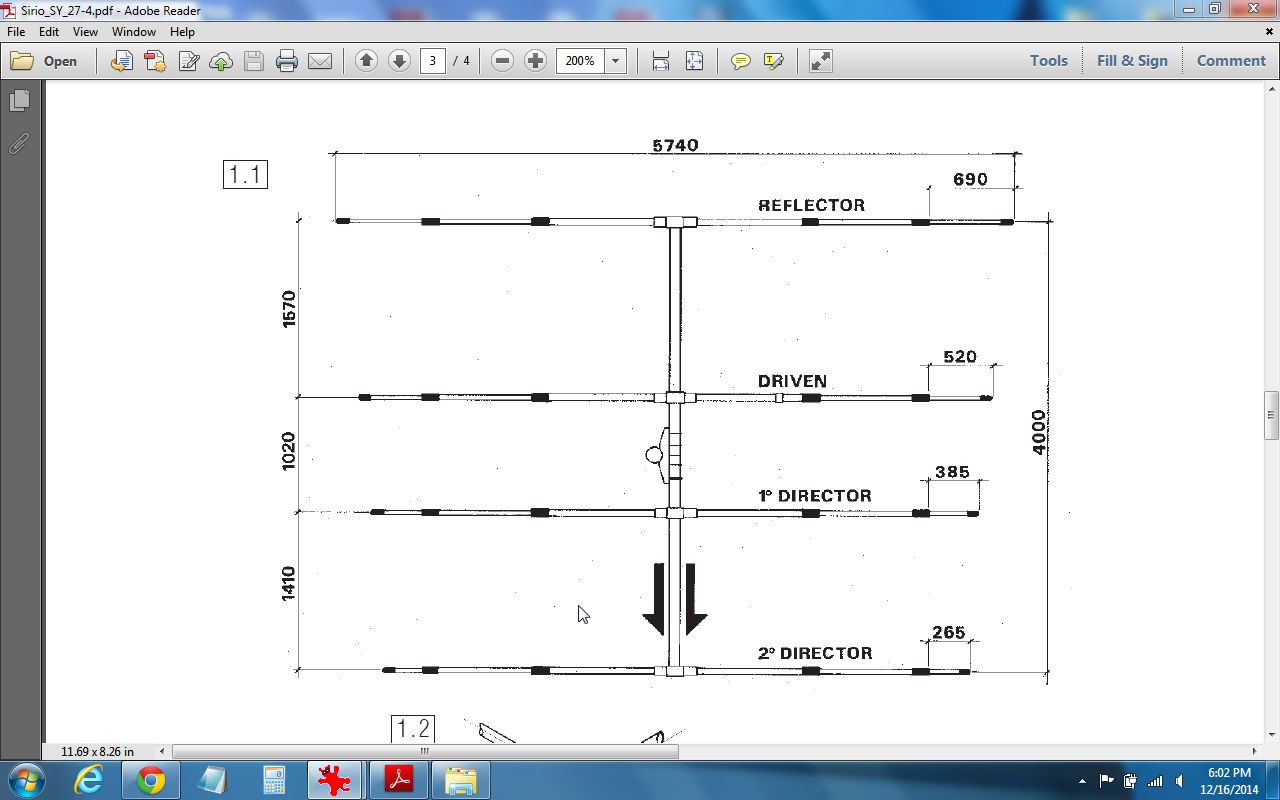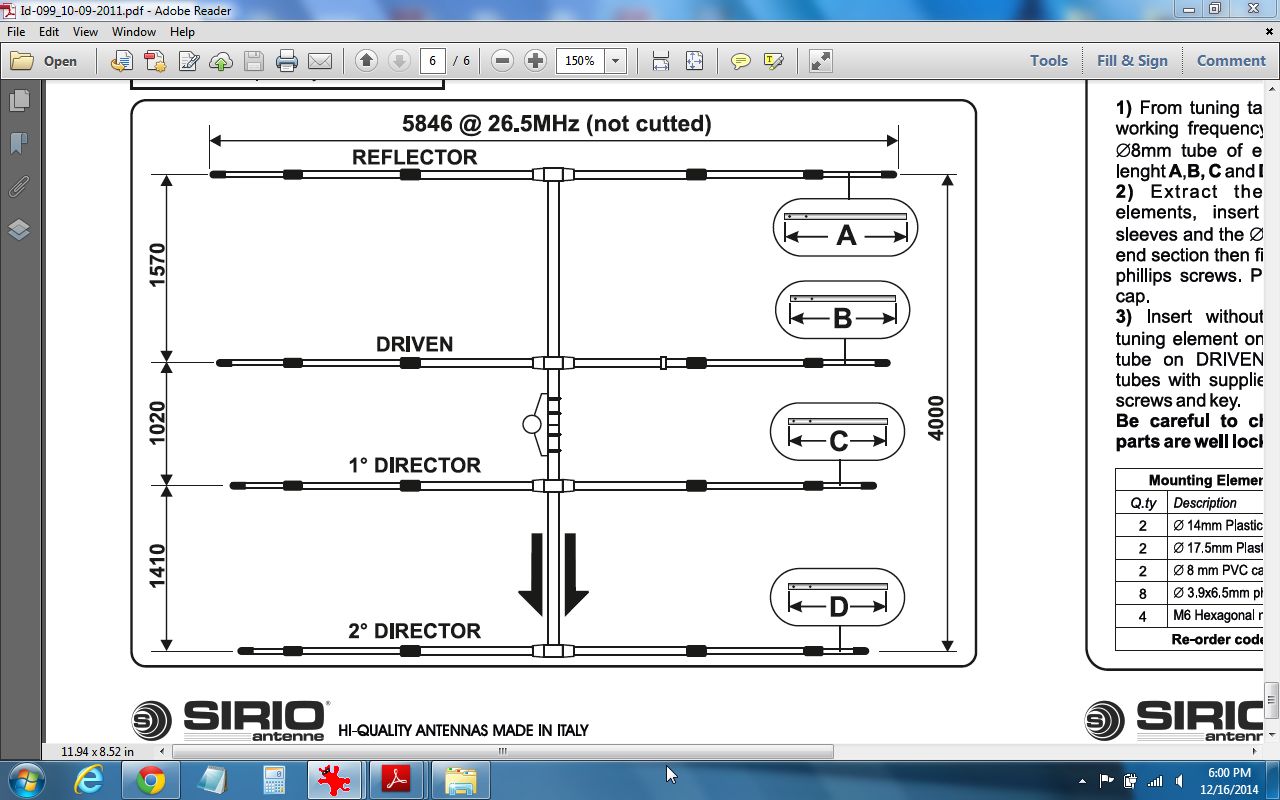Actually, the SWR is very low and flat across the CB band and only needs a small bump from an antenna tuner to get it to work on 10m. With the MFJ-259B, I saw the resonant freq point at/about 27.520mhz. I think that 13.5dbi is a little generous too, as I'll bet it is closer to 11dbi @ 1 wavelength above ground.
You are using an out of date browser. It may not display this or other websites correctly.
You should upgrade or use an alternative browser.
You should upgrade or use an alternative browser.
-
You can now help support WorldwideDX when you shop on Amazon at no additional cost to you! Simply follow this Shop on Amazon link first and a portion of any purchase is sent to WorldwideDX to help with site costs.
need info on how to modify a sirio sy27-4 for 10m
- Thread starter eacky
- Start date
Actually, the SWR is very low and flat across the CB band and only needs a small bump from an antenna tuner to get it to work on 10m. With the MFJ-259B, I saw the resonant freq point at/about 27.520mhz. I think that 13.5dbi is a little generous too, as I'll bet it is closer to 11dbi @ 1 wavelength above ground.
You many be right Robb, but Sirio published the results differently and they report to use CST to model their antennas and it is supposed to be the best in the world.
In the specifications they show 11 dbd and 13.15 dbi clear as day in the attached page from their manual.
I'm just curious about the difference in the dimensions for this beam, and why I get the beam way low out of the CB frequency...when I took the dimensions for 27.205 approximately.
Attachments
Last edited:
The brackets are held with a hex key (allen key) grub screw down the inside of the element tube it's very easy to change the spacing. Don't change the spacing it actually works in your favor ( boom is slightly longer than scaled up length) Here are the lengths I used
REF 5.224
DRIVEN 5.101
Dir 4.921
DIR 2 4.681
Don't cut the elements push them in and redrill for the set screws. Mine didn't need the gamma adjusted but you may have to adjust it.( sorry didn't measure mine) Works a treat and well worth the effort.
Marconi what element diameter did you use to allow for taper I used 12 mm.
REF 5.224
DRIVEN 5.101
Dir 4.921
DIR 2 4.681
Don't cut the elements push them in and redrill for the set screws. Mine didn't need the gamma adjusted but you may have to adjust it.( sorry didn't measure mine) Works a treat and well worth the effort.
Marconi what element diameter did you use to allow for taper I used 12 mm.
Last edited:
If you just use the tuner to get the frequency coverage the front to back is severely degraded on 10 meters ( about 3 s points) That might be ok for some but I preferred to optimize it .I think the quoted gain is a little generous as well as the front to back ratio.
The brackets are held with a hex key (allen key) grub screw down the inside of the element tube it's very easy to change the spacing. Don't change the spacing it actually works in your favor ( boom is slightly longer than scaled up length) Here are the lengths I used
REF 5.224
DRIVEN 5.101
Dir 4.921
DIR 2 4.681
Don't cut the elements push them in and redrill for the set screws. Mine didn't need the gamma adjusted but you may have to adjust it.( sorry didn't measure mine) Works a treat and well worth the effort.
Marconi what element diameter did you use to allow for taper I used 12 mm.
VK, as noted on the antenna view of the antenna model on my post #15 above, I used the average of .50" inches for the element diameters. I just guessed at the diameters, and I figured the taper was probably a mix of .625", .50", .375" inches.
Eznec does not model taper well, so I average all diameters. This will make a difference for sure, but it will not be an error to the degree my results are showing.
Last edited:
Thanks marconi. It not just me then, I couldn't get the original to model real well either .
Well VK, my reason for trying to do the Siro beam was, because I like the more traditional spacing that looks to have been used on this Sirio beam.
I see this design resulting in a shorter boom, producing good gain, while manifesting better wide band rejection than many consider...the other 1/2 of the function for a beam.
I have one other consideration why this happens, but I think I will leave that explanation for another day. Too much information at one time is not good for the digestion.
Here are some clues though. Besides the fact that the antenna that I made resonates way down in 26 mhz, which IMO is just a mistake somewhere...this beam shows a very nice gain, and this is what I see mostly using the old traditional style of well balanced beam design.
I'm from the old school of antenna design that symmetry in design is very important if real performance is consider...and matching is only a means to an end, and in the real world matching contributes very little practical benefit to performance as long as the match is realistic and not off into the weeds.
In my book, I think I just proved my point that all this optimization stuff is subject to compromises that few consider, me thinks.
Sometimes it is better to let mother nature work as she intends instead of trying to force her to simply make your meter happy.
New is not always better, in my book.
Now all we have to do is figure out why my 27.205 mhz model produced results at 26.3 mhz instead of where it was supposed to.
VK, thanks for confirming that you found some dimensions from Sirio as whack-O too. I will go back and recheck all of my work however...just in case.
Last edited:
The old sirio sy-4 has shorter elements and frequency range from 26.9 to 27.5
The new one has longer elements and frequency range from 26.5 to 30 mhz
Both antennas have the same element spacing


The new one has longer elements and frequency range from 26.5 to 30 mhz
Both antennas have the same element spacing
The old sirio sy-4 has shorter elements and frequency range from 26.9 to 27.5
The new one has longer elements and frequency range from 26.5 to 30 mhz
Both antennas have the same element spacing


Very good tecnicoloco, I hoped somebody would take a chance and come forward with a good word. No wonder my model presented at 26.300 mhz, I started with the none adjustable tapered base elements for the setting at 26.500. I just missed the distinction in the header.
I can fix the model now.
Thanks for the help.
Last edited:
Sirio - no doubt - did use the latest software to design this antenna, so it doesn't surprise me that the standard EZNEC software doesn't like it. I think that is a very clear signal that EZNEC isn't current any more.
BTW; what is the newest whiz/bang antenna software?
BTW; what is the newest whiz/bang antenna software?
Sirio - no doubt - did use the latest software to design this antenna, so it doesn't surprise me that the standard EZNEC software doesn't like it. I think that is a very clear signal that EZNEC isn't current any more.
BTW; what is the newest whiz/bang antenna software?
Robb, I don't think this issue I presented has anything at all to do with Eznec being outdated or not current anymore. I made the mistake and did not read what you posted for the distinction that Technicoloco brought out in his post.
I'll fix the model and we'll see if it then nails the antenna modeled like it did with the misinformation I entered.
This just came to my attention...and obviously you missed the it too. Technicoloco was paying attention and I thank him.
After I redo the model I will let you know if you need to get some new "tea leaves?"
Attachments
Last edited:
Before we get to deep into software...
There are many different kinds of software.
There are many different "methodes" of calculation.
MOM is one of them.
Its a problem solver that uses the "methode of moment" to solve a issue.
There are different ways to setup that way of calculating.
Well known examples are the different engines MOM software uses.
NEC2, MININEC, NEC4 etc.
There are "problems" where one engine handles the situation more accurate than anther.
MOM is known to be accurate for most situations.
There are other "electro magnetic wave" solvers.
Like fdtd (rather famous) but others as well.
CST has different solvers for each application.
And for sure is valuable in many aspects.
But for us "antenna enthusiasts" we are not really interested in things like:
Will the heat that will be generated in the corner of a wave guide when a missile from a ship is launched at 10 feet from it have any effect on the wave in it etc.
If I phone with my cell phone...how far will the em wave penetrate my head.
Hope it is of use...
Kind regards,
H.
There are many different kinds of software.
There are many different "methodes" of calculation.
MOM is one of them.
Its a problem solver that uses the "methode of moment" to solve a issue.
There are different ways to setup that way of calculating.
Well known examples are the different engines MOM software uses.
NEC2, MININEC, NEC4 etc.
There are "problems" where one engine handles the situation more accurate than anther.
MOM is known to be accurate for most situations.
There are other "electro magnetic wave" solvers.
Like fdtd (rather famous) but others as well.
CST has different solvers for each application.
And for sure is valuable in many aspects.
But for us "antenna enthusiasts" we are not really interested in things like:
Will the heat that will be generated in the corner of a wave guide when a missile from a ship is launched at 10 feet from it have any effect on the wave in it etc.
If I phone with my cell phone...how far will the em wave penetrate my head.
Hope it is of use...
Kind regards,
H.
dxChat
- No one is chatting at the moment.
-
@ Wildcat27:Hello I have a old school 2950 receives great on all modes and transmits great on AM but no transmit on SSB. Does anyone have any idea?
-
-
-
dxBot:63Sprint has left the room.
-
dxBot:kennyjames 0151 has left the room.
